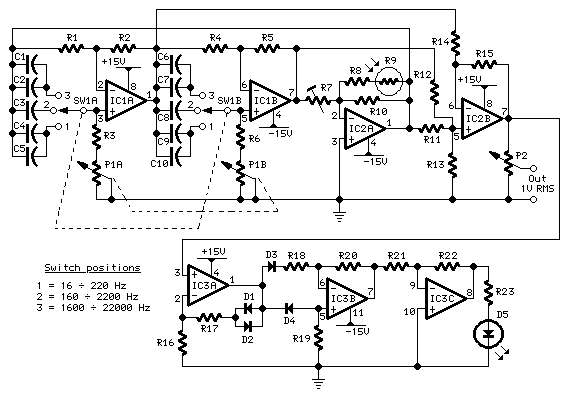Low-distortion Audio-range Oscillator
Generates very low-distortion sine waves up to 1V RMS
No thermistors required - No settling time

Parts:
P1_____________10K Log. Potentiometer (Dual-ganged)
P2______________2K2 Linear Potentiometer
R1,R2,R4,R5_____3K3 1/4W Resistors
R3,R6_________820R 1/4W Resistors
R7_____________10K 1/2W Trimmer Cermet
R8_____________22K 1/4W Resistor
R9_____________Photo resistor (any type)
R10_____________8K2 1/4W Resistor
R11,R12,R14,R15_3K3 1/4W Resistors
R13_____________2K7 1/4W Resistor
R16--R20________3K3 1/4W Resistors
R21____________56K 1/4W Resistor
R22____________68K 1/4W Resistor
R23_____________1K 1/4W Resistor
C1,C6_________220pF 63V Polystyrene Capacitors
C2,C7___________8n2 63V Polyester Capacitors
C3,C8__________82nF 63V Polyester Capacitors
C4,C9_________150nF 63V Polyester Capacitors
C5,C10________680nF 63V Polyester Capacitors
D1--D4______1N4148 75V 150mA Diodes
D5_____________LED 5mm. Red
IC1,IC2_____NE5532 Low noise Dual Op-amps
IC3__________TL084 Quad BIFET Op-Amp
SW1__________2 poles 3 ways rotary switch
Comments:
Producing low-distortion sine waves, this oscillator operates over the range
16 to 22000 Hz. The circuit is based on two articles that have appeared earlier
in Wireless World - Roger Rosens' "Phase -Shifting Oscillator", February 1982 pp.
38-41, and J. L. Linsley Hood's "Wien-Bridge Oscillator with low harmonic
distortion" from May 1981 pp. 51-53.
This design features the simplicity of the Rosens' circuit but avoids the use of
a thermistor. Instead, oscillator stability is controlled by means of a common
photo-resistor driven by a LED, as suggested in the Linsley Hood article.
There is no settling time when the oscillator's frequency is changed and no
bouncing of the output waveform. Use of an expensive and sometimes difficult to
obtain thermistor is avoided.
Technical data:
- Output voltage:
- Sine wave, 1V RMS max.
Total harmonic distortion @ 1V RMS output:
Frequency Reading
100Hz = 0.0035%
300Hz = 0.0028%
1kHz = 0.002 %
3kHz = 0.002 %
10kHz = 0.001 %
Notes:
- Any common photo-resistor and 5mm. red LED can be used, provided they are in close contact and enclosed in a light-proof small box. I used the metal screen of a small IF transformer for AM transistor radios sealed with black insulating tape.
- The 10K trimmer must be set to obtain a 1V RMS output.
- The circuit must be supplied by a + and - 15V dual regulated supply. Common 7815 and 7915 regulator ICs should be used for this purpose.
This circuit was awarded with publication in ELECTRONICS WORLD "Circuit Ideas", February 2003 issue, page 38.
Title: Low-distortion Audio-range Oscillator
electronic circuit
Source: www.redcircuits.com
Published on: 2005-02-03
Reads: 991
Print version: ![]()
Other electronic circuits and schematics from Oscillators and timers
-
Simple IF Signal Generator
-
Tan Timer
-
9 Second Digital Readout Countdown Timer
-
Sawtooth wave generator
-
28 LED Clock Timer
-
Jogging Timer
-
Low Voltage, High Current Time Delay Circuit
-
1KHz Sinewave Generator
-
Amplifier Timer
-
Headlights Timer
